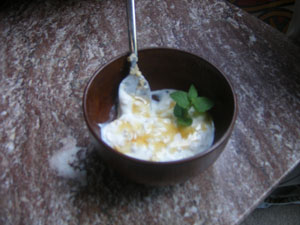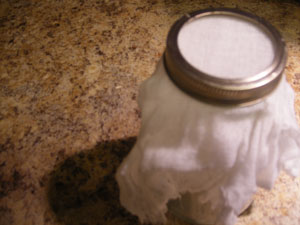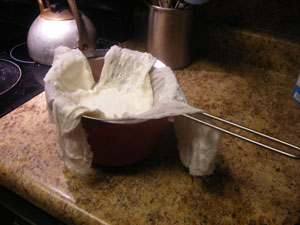 In an effort to eat a bit healthier but still eat creamy things, I’ve started using a lot of Greek yogurt. You can substitute the stuff for sour cream or mayonnaise just about anywhere. It’s fat-free (or very low in fat, depending on your variety), and though it’s not exactly the same as the good stuff (it just won’t work in tuna salad, for example), it adds a nice tangy flavor.
In an effort to eat a bit healthier but still eat creamy things, I’ve started using a lot of Greek yogurt. You can substitute the stuff for sour cream or mayonnaise just about anywhere. It’s fat-free (or very low in fat, depending on your variety), and though it’s not exactly the same as the good stuff (it just won’t work in tuna salad, for example), it adds a nice tangy flavor.
I recently joined a co-op to buy milk from Wright Dairy, a local source that makes some fantastic milk and cheese, and figured it was time to stop buying Fage. (Not that Fage is a bad brand; it’s been my standby for a long time.)
Now, yogurt is quite literally spoiled milk, but the key to making it is to control the bacteria doing the spoiling. You want lactobacilli: They break down milk’s sugar, lactose, into lactic acid. (Lactobacilli are the kings of food fermentation; they’re responsible for cheese, sauerkraut, kimchi, and sourdough bread too.) Once the milk gets acidic enough, its proteins denature, causing to to curdle and creating yogurt’s thick texture.
Luckily, this particular kind of bacterial husbandry is really easy. It takes two ingredients and three steps.
You need:
- a lot of milk (skim or low-fat; using whole kinda defeats the healthier-than-sour-cream purpose)
- a little yogurt (this can be from a previous batch, or fresh store-bought yogurt with live active cultures [see step 2])
Step 1: Microorganism Genocide
In order to make sure it’s only lactobacilli turning your milk into yogurt, you first have to kill all the other stuff in there. This makes sure you end up with yogurt and not fuzzy green nastiness. You do this with heat, but online recipes I found varied: Some said to boil the milk, others said heat till it steams. I went with science; 185° F is high enough to kill basically anything, and I was worried going all the way to boiling might scorch my milk.
Anyway, pour the milk into a pot, put it over medium heat and stick a thermometer in it. When you hit 185, take it off the heat.
Step 2: Inoculate!
Your milk is now (reasonably) sterile. But it’s also hot enough to kill any lactobacilli you add now. So stick your pot in an ice bath and cool the milk down below 120°. You want it pretty warm (which is good for bacterial growth). I stopped the cool-down at 110°.
 Stir a good glop of your yogurt into the warm milk (roughly 2 tablespoons for a quart, but you really don’t need to measure), and pour into a vessel of some kind. I used a quart Mason jar with a piece of cheesecloth screwed on top—because I like to pretend I’m an old-timey farm wife sometimes, and also because it holds heat really well.
Stir a good glop of your yogurt into the warm milk (roughly 2 tablespoons for a quart, but you really don’t need to measure), and pour into a vessel of some kind. I used a quart Mason jar with a piece of cheesecloth screwed on top—because I like to pretend I’m an old-timey farm wife sometimes, and also because it holds heat really well.
Two things to keep in mind here: First, your yogurt “starter” needs to have live lactobacilli in it. Look for yogurt labeled “live, active cultures” (some brands pasteurize the yogurt after fermentation, which renders it useless as a starter), and try to use very fresh yogurt (my first attempt at this used old, though not expired, store-bought. It didn’t work.) Second, your fermentation vessel needs to be open to the air. Cheesecloth is an excellent option, or if you’re using a plastic container, poke some holes in the lid.
Step 3: Wait
Now let your vessel sit somewhere warm. Don’t touch it, don’t shake it, just leave it there. For like eight hours. At least. The longer you let it sit, the tangier the finished product. If it doesn’t thicken after eight hours, or if it grows green fuzz, or if it just smells off, throw it out. Your yogurt starter probably wasn’t active enough.
Bonus Round: Make it Greek
 Congratulations! You are now the proud owner of some yogurt. To turn your plain yogurt into thicker, creamier Greek yogurt, you just have to strain it. Line a colander with cheesecloth, put it atop a bowl, pour in the yogurt, and stick it in the fridge. After about three hours, you’ll have Greek yogurt. The longer it strains, the thicker it’ll be. Err on the side of too thick; you can always stir some of the drained-off liquid back in to thin it out.
Congratulations! You are now the proud owner of some yogurt. To turn your plain yogurt into thicker, creamier Greek yogurt, you just have to strain it. Line a colander with cheesecloth, put it atop a bowl, pour in the yogurt, and stick it in the fridge. After about three hours, you’ll have Greek yogurt. The longer it strains, the thicker it’ll be. Err on the side of too thick; you can always stir some of the drained-off liquid back in to thin it out.
You can eat your Greek yogurt for breakfast with a little honey and oats stirred in, use it to make sandwich spreads (yogurt+salt and pepper+dill is great with ham), or marinate chicken in it before grilling. Or try it in place of mayo in a slaw recipe. Or stir some into marinara sauce for a great pink pasta sauce. Or leave a comment with your favorite yogurt recipe.
We make 3 – 4 quarts of yogurt cultured with Activia every couple of days – yes, we eat a lot of yogurt – and yes, it does as advertised. Our recipe is to add a cup of dry, powdered milk for every quart of liquid (whole) milk plus a tablespoon of sugar and a pinch of salt for the batch. It turns out creamy and thick and very, very tasty. For more information: http://mryogurt.info/